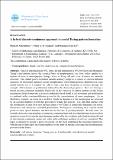A hybrid discrete-continuum approach to model Turing pattern formation
Abstract
Since its introduction in 1952, with a further refinement in 1972 by Gierer and Meinhardt, Turing’s (pre-)pattern theory (the chemical basis of morphogenesis) has been widely applied to a number of areas in developmental biology, where evolving cell and tissue structures are naturally observed. The related pattern formation models normally comprise a system of reaction-diffusion equations for interacting chemical species (morphogens), whose heterogeneous distribution in some spatial domain acts as a template for cells to form some kind of pattern or structure through, for example, differentiation or proliferation induced by the chemical pre-pattern. Here we develop a hybrid discrete-continuum modelling framework for the formation of cellular patterns via the Turing mechanism. In this framework, a stochastic individual-based model of cell movement and proliferation is combined with a reaction-diffusion system for the concentrations of some morphogens. As an illustrative example, we focus on a model in which the dynamics of the morphogens are governed by an activator-inhibitor system that gives rise to Turing pre-patterns. The cells then interact with the morphogens in their local area through either of two forms of chemically-dependent cell action: Chemotaxis and chemically-controlled proliferation. We begin by considering such a hybrid model posed on static spatial domains, and then turn to the case of growing domains. In both cases, we formally derive the corresponding deterministic continuum limit and show that that there is an excellent quantitative match between the spatial patterns produced by the stochastic individual-based model and its deterministic continuum counterpart, when sufficiently large numbers of cells are considered. This paper is intended to present a proof of concept for the ideas underlying the modelling framework, with the aim to then apply the related methods to the study of specific patterning and morphogenetic processes in the future.
Citation
Macfarlane , F R , Chaplain , M A J & Lorenzi , T 2020 , ' A hybrid discrete-continuum approach to model Turing pattern formation ' , Mathematical Biosciences and Engineering , vol. 17 , no. 6 , pp. 7442-7479 . https://doi.org/10.3934/mbe.2020381
Publication
Mathematical Biosciences and Engineering
Status
Peer reviewed
ISSN
1547-1063Type
Journal article
Description
Funding: MAJC gratefully acknowledges support of EPSRC Grant No. EP/N014642/1 (EPSRC Centre for Multiscale Soft Tissue Mechanics–With Application to Heart & Cancer)Collections
Items in the St Andrews Research Repository are protected by copyright, with all rights reserved, unless otherwise indicated.

